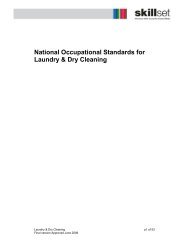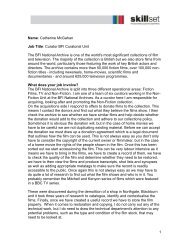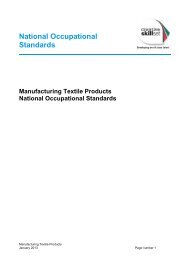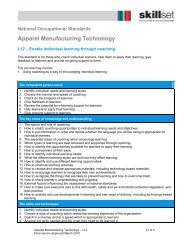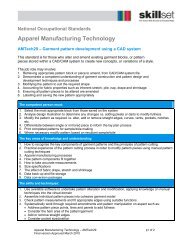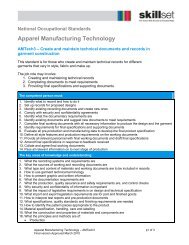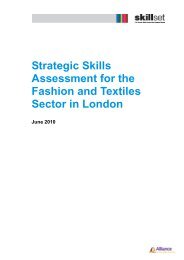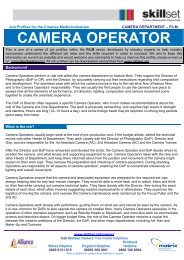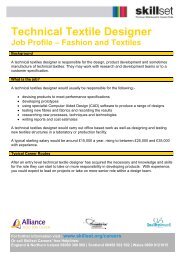CAREER PROFILE CLOTHING ALTERATION HAND - Skillset
CAREER PROFILE CLOTHING ALTERATION HAND - Skillset
CAREER PROFILE CLOTHING ALTERATION HAND - Skillset
You also want an ePaper? Increase the reach of your titles
YUMPU automatically turns print PDFs into web optimized ePapers that Google loves.
Leather technologists<br />
supervise and manage<br />
the process of the<br />
conversion of raw hides<br />
and skins into leather<br />
used to make a variety of<br />
products, including shoes,<br />
accessories and upholstery.<br />
What does a leather<br />
technologist do<br />
A leather technologist’s work is<br />
both scientific and technical. They<br />
may be involved in the process of<br />
turning the raw animal hides and<br />
skins into leather. Technologists<br />
will also be involved in the scientific<br />
side of leather production, including<br />
developing the appropriate dyes<br />
and finishes and experimenting<br />
with new techniques.<br />
The salary of a leather<br />
technologist<br />
The starting salary for a leather<br />
technologist may be around £14,000<br />
a year. This would increase to around<br />
£20,000 a year with experience. At<br />
senior level, a leather technologist<br />
could earn over £30,000 a year.<br />
Hours and working environment<br />
Leather technologists employed in a<br />
tannery would work around 40 hours<br />
a week. Shift work may be involved<br />
and overtime and part-time hours<br />
may be available.<br />
Some technologists work in a tannery<br />
environment, which can be dirty<br />
and smelly. They may have a small<br />
laboratory attached to the tannery<br />
where they can perform experiments.<br />
Other technologists work in a factory<br />
environment or workshop.<br />
Skills and interests<br />
To have a career as a leather<br />
technologist, it may be useful to<br />
have some of the following skills<br />
and interests:<br />
* to be good at science, particularly<br />
chemistry and have good<br />
numeracy and IT skills<br />
*<br />
*<br />
*<br />
to be able to plan projects and<br />
communicate ideas effectively<br />
to be able to manage and<br />
supervise others and work<br />
as part of a team<br />
have some knowledge of<br />
mechanics and engineering<br />
Entry into a career in<br />
leather technology<br />
A wide range of qualifications are<br />
available in the field of leather<br />
technology and entry into a job in<br />
this area is possible in a variety of<br />
different ways. Apprenticeship and<br />
NVQs in footwear and leather goods<br />
offer a route in, however the main<br />
qualifications for leather technology<br />
are awarded by the British School of<br />
Leather Technology at the University<br />
of Northampton.<br />
Further training to develop a<br />
career in leather technology<br />
Continued professional development<br />
is very important in this area and<br />
there are a number of professional<br />
courses available, which will help an<br />
experienced technologist progress<br />
their career.<br />
The British School of Leather<br />
Technology at the University of<br />
Northampton, The Society of Dyers<br />
and Colourists (SDC) and The BLC<br />
Leather Technology Centre all offer<br />
a wide range of training courses for<br />
the leather industry.<br />
Opportunities in the field<br />
of leather technology<br />
It may be possible to move from<br />
work as a leather technologist to<br />
other jobs in production, quality<br />
control, research or technical<br />
management. Technologists can<br />
also move into related areas such<br />
as buying, sales or marketing. There<br />
are good opportunities for leather<br />
technologists to work abroad or set<br />
up their own consultancy business.<br />
Case study<br />
Amanda Michel is a<br />
leather technologist<br />
for her own company,<br />
Leather Wise Ltd, offering<br />
problem solving and<br />
training services to the<br />
leather supply chain.<br />
Amanda is involved with<br />
virtually every aspect of<br />
the leather business from<br />
the animal on the farm,<br />
through each stage of the<br />
leather making process,<br />
onto product design and<br />
manufacture. Amanda<br />
says “My core business is<br />
to do with helping people<br />
with problems they may<br />
have with their leather. For<br />
example, if someone has<br />
bought a leather sofa and<br />
the colour is coming off, I<br />
can run a series of tests such<br />
as rub fastness or looking<br />
at it under a microscope.<br />
This will determine whether<br />
the customer is entitled to<br />
a replacement or their<br />
money back.”<br />
Amanda has acted as an<br />
expert witness for trading<br />
standards and is also an<br />
information resource for<br />
all aspects of the leather<br />
supply chain. She has<br />
articles regularly published<br />
in the trade press. Amanda<br />
adds “I really enjoy my job<br />
as every day is different<br />
and each day brings a<br />
new challenge!”<br />
For more information visit<br />
www.skillfast-uk.org/generationf



